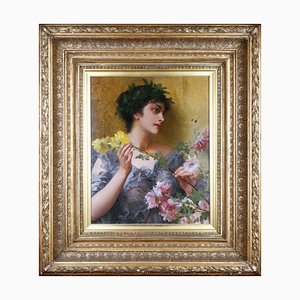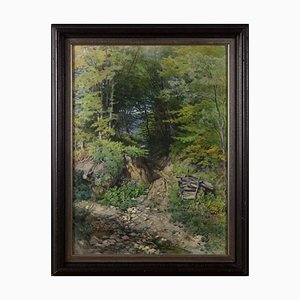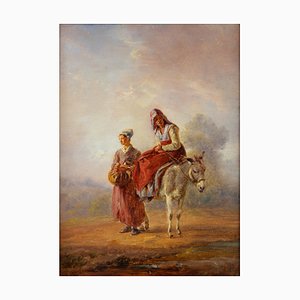Franz Xaver Gräßel [Grässel] (1861 Oberasbach/Baden - 1948 Emmering). In the forest of Durlach. 1881. Pencil drawing, heightened with white, on grey-green paper. 33 x 41.7 cm. Signed, dated and inscribed by the artist himself: 'Franz Gräßel. Durlach, 12 April 1881".
- Quiet ripple in a secret place -
About the artwork
The drawing depicts a view of the woods which, as if sharpening the visual focus, remains diffuse at the edges and does not allow the viewer to locate himself in the picture. As a result, the landscape appears to be an apparition, but at the same time it is given real substance by the solidity of the massive arched bridge made of quarry stone. As the main motif of the painting, the bridge, which blends in with nature like an archaic relic, also acts as a visual guide, drawing attention to the white, raised waters of the stream and the surrounding vegetation. The diffusion of perception that takes place there, however, draws the eye back to the bridge and thus to the overall view. This movement initiating a constant alternation of diffusion and concretion, which is the specific tension of the painting that brings the landscape to life. The materialisation and dematerialisation, however, does not take place solely through the eye's wandering through the picture; it is simultaneously linked to the viewer's approach to and distance from the picture, which loses its richness of detail precisely in the close-up, only to reconfigure itself with increasing distance.
In this work, which dates from Gräßel's studies in Karlsruhe, the artist reflects on the emergence of pictorial objectivity. Here, however, nature is more than a mere motif. The real connection between culture and nature is symbolically expressed by the choice of green paper.
The drawing is an impressive testimony to Gräßel's mastery of the sprezzatura with which he skilfully applies the most abstract of strokes, which visibly merge towards the centre of the picture. The signature and the exact date prove that Gräßel gave this work more than the character of a mere sketch.
About the artist
Franz Gräßel grew up in an environment that was to nourish his later key motifs: his parents' house was a mill. After attending the Karlsruhe Academy of Art from 1878 to 1884, where he studied under Carl Hoff, Gräßel continued his training at the Munich Academy from 1886 to 1890 as a pupil of Wilhelm von Lindenschmidt. Trained primarily in genre and portrait painting, he initially portrayed the life of Black Forest farmers. from 1894 he turned increasingly to animal painting, concentrating on the depiction of ducks and geese, which earned him the nickname 'Enten-Gräßel'. Gräßel's work thus parallels that of Alexander Koester (1864-1932), who was also known as 'Duck-Koester'. Koester had begun studying art the year after Gräßel left Karlsruhe, also with Carl Hoff, and later, like Gräßel, went to Munich. Like Koester, however, Gräßel continued to paint portraits and landscapes as well as animals.
In 1900 Gräßel turned his back on the big city and moved from Munich to Emmering near Fürstenfeldbruck, where a number of artists who became known as the 'Brucker Maler' settled in Gräßel's wake. Due to his national and even international success, Gräßel was appointed Royal Academy Professor at the Munich Academy of Fine Arts by Prince Regent Luitpold in 1911. In 1914 the first exhibition of local artists was held in Bruck's town hall, and in 1924 the Fürstenfeldbruck Artists' Association was founded, of which Gräßel was honorary chairman.
Gräßel was a regular participant in the annual exhibitions at the Glaspalast in Munich, where he often acted as a juror. Franz Hanfstaengel's 'Kunst unserer Zeit' and 'Jugend' regularly published reproductions of Gräßel's paintings. Among his most prominent collectors were Prince Regent Luitpold of Bavaria, Kaiser Wilhelm II and the Khedive of Egypt, Said Halim Pasha.
Gräßel was a member of the Munich Artists' Association, the Isar Artists' Association, the Munich Watercolourists' Association and the Munich Art Association. He received numerous awards: in 1888 he received the second medal of the academy for his painting 'At Work', which shows his three sisters in the traditional costume of Black Forest farmers; in 1897 he received the second and in 1909 the first gold medal at the International Art Exhibition in Munich. In 1903 Gräßel was awarded the Silver State Medal of Salzburg and in 1910 the Silver Medal of the Buenos Aires International Art Exhibition.
Selection of public collections that own works by Franz Gräßel:
Alte Nationalgalerie Berlin, Art Gallery Glaskow, Augustiner-Museum Freiburg i. Br., Neue Pinakothek München, Städtische Galerie München.
Selective Bibliography
Karl Trautmann: Professor Franz Gräßel (genannt "Enten-Gräßel") zum Gedenken. In: Amperland 10 (1974), S. 531-563.
Heidi C. Ebertshäuser: Malerei im 19. Jahrhundert. Münchner Schule. Gesamtdarstellung und Künsterlexikon, München 1979.
Horst Ludwig: Münchner Maler im 19. Jahrhundert. Bd. 2: Gebhardt - Küstner, München 1982.
Walter G. Well: Maler im Fürstenfeldbrucker Land. Ein Erinnerungsbuch, München 1988.
Hans H. Hofstätter (Hg.): Kunst und Künstler in Baden, Stuttgart 1995.
Dirk Hoogen (Hg.): Maler in Bruck. Ein Katalog zur Sammlung der Sparkasse Fürstenfeldbruck anläßlich der Ausstellung zum 50. Todestag von Franz Gräßel, Fürstenfeldbruck 1998.
Bayerische Staatsgemäldesammlungen, Neue Pinakothek (Hg.): Deutsche Künstler von Marées bis Slevogt, Bd. 1, München 2003.
Margret Zimmermann (Hg.).: Gemälde des 19.und 20. Jahrhunderts - Augustiner Museum Freiburg, Freiburg im Breisgau 2004.




















Get in Touch
Make An Offer
We noticed you are new to Pamono!
Please accept the Terms & Conditions and Privacy Policy
Get in Touch
Make An Offer
Almost There!
To follow your conversation on the platform, please complete the registration. To proceed with your offer on the platform, please complete the registration.Successful
Thanks for your inquiry, someone from our team will be in touch shortly
If you are a Design Professional, please apply here to get the benefits of the Pamono Trade Program